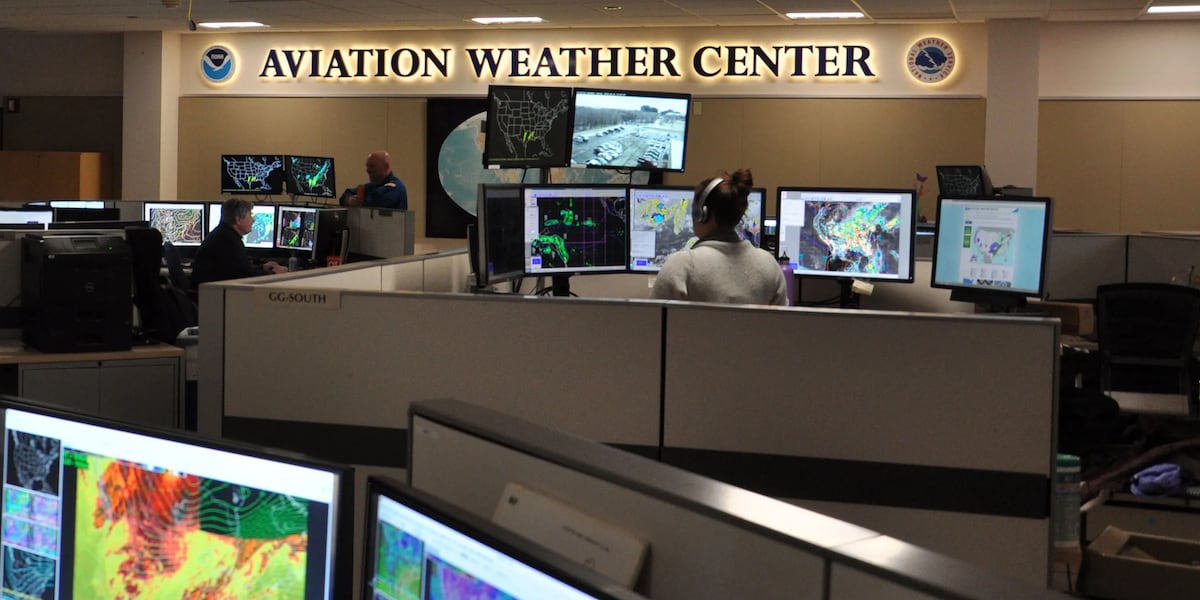How the Aviation Weather Center forecasts hazards to ensure smooth and safe flights
A variety of weather factors can delay flights or cause turbulence when we’re in the air. The Aviation Weather Center forecasts these hazards. The Aviation Weather Center in Kansas City, Missouri, provides weather warnings and forecasts for flights due to weather factors such as high winds, turbulence mid-flight, or an impactful storm system. The center ensures the most accurate and updated weather information for pilots. Forecasts are made for icing, which can accumulate on planes and lead to increased drag and weight. The FAA uses these forecasts as a planning tool to place restrictions or alter routes based on the weather. The Aviation Weather Centre also has an international branch for overseas flights and works with other countries to produce global graphics. The agency has updated its website to make it more user and mobile-friendly.

发表 : 一年前 经过 Jacob Morse 在 Weather
KANSAS CITY, Mo. (KFYR) - A variety of weather factors can delay flights or cause turbulence when we’re in the air. The Aviation Weather Center forecasts these hazards.
Aviation is heavily impacted by weather from high winds at the point of takeoff to turbulence mid-flight to an impactful storm system causing a plane to be rerouted.
Located in Kansas City, the Aviation Weather Center ensures the most accurate and up-to-date weather information is available for pilots.
Forecasts are made for icing as it can accumulate on planes in various situations and levels of the atmosphere and lead to increased drag and weight.
The height of clouds off the ground and visibility are also closely monitored for safe takeoff and landing.
Turbulence can be caused by a variety of factors from thunderstorms to mountains to different jet stream speeds, called clear air turbulence. Reports are gathered and forecasts are made so planes can avoid extreme turbulence.
These are the three area forecast desks, but the Aviation Weather Center also issues warnings.
“We also have a convective SIGMET desk, which is our warning desk. And that’s basically just for thunderstorm warnings for airplanes,” said Amanda Martin. “They’re watching radar, they’re watching satellite trends, and they’re also looking at different model guidance to put out an outlook where they think there will be the potential for development in the future.”
Their traffic flow management forecasts serve as a planning tool for the FAA so they can put restrictions or alter routes based on the weather.
“Our core partners are really the FAA and our CWSUs, which are our Center Weather Service Units, and those are the aviation forecasters that are placed at the air route traffic control centers. They’re making these real-time decisions based off of weather and helping planes to make the best use the airspace,” said Martin.
The Aviation Weather Center also has an international branch for overseas flights and works with other countries to produce global graphics.
Additionally, they collaborate with commercial airlines that also employ meteorologists.
“We want to give everybody the same message, and so, it’s important that we’re all staying on the same page so that we can promote safe and efficient flight across the airspace system,” said Martin.
The Aviation Weather Center recently updated its website to make it more user and mobile-friendly.
NCEP Series Part 7: How the National Hurricane Center forecasts the track, intensity and impacts of tropical cyclones
NCEP Series Part 6: How the Ocean Prediction Center provides warnings and forecasts to protect life and property at sea
NCEP Series Part 5: How the Storm Prediction Center forecasts severe t-storm and wildfire risks nationally
NCEP Series Part 4: How the Weather Prediction Center creates charts, forecasts and outlooks for fronts, precipitation and more
NCEP Series Part 3: How the Climate Prediction Center uses models and teleconnections to create long-range outlooks for temperature, precipitation and more
NCEP Series Part 2: How the Environmental Modeling Center develops and improves weather forecast models
NCEP Series Part 1: How the Space Weather Prediction Center monitors the sun for impacts to Earth
话题: Aviation
